The Roots of a Virginia Christmas
Our contemporary Christmas celebration is an amalgamation of many diverse strands of meaning, custom, and tradition. The first English colonists who ventured to Virginia on behalf of the Virginia Company of London brought their traditions and customs with them. And those customs were already an odd mix drawing bits from the ancient world of the Neolithic Celts, the Greeks and the Romans; all molded into the contemporary post-Reformation culture of urban England.
Keep in mind that the earliest Virginia colonists were a mix of gentlemen, craftsmen, and soldiers. English colonists came to Virginia as a business venture to find gold, as the Spanish had further south, and to look for that elusive trade route to the rich markets of Asia. Unlike their Puritanical cousins who settled further north along the coast 13 years later, they were members of the Church of England, and came in search of profit rather than free exercise of their religion. Unsuccessful in those early attempts to find gold or other valuable minerals, they eventually settled on turning a profit from agriculture and trade.

A Southern Catalpa tree grows in front of the St. George Tucker house at Colonial Williamsburg, December 2013. The evergreen tree to the left is a Virginia live oak, Quercus virginiana.
Traditional English Christmas celebrations in Virginia lasted from Christmas Eve until Twelfth Night and were about good food, plentiful drink, and merry making. There was a church service to mark Christmas Day.
Huge Yule logs burned in hearths during the celebration. The largest log available would be brought inside to burn at Christmas because the celebration lasted as long as the fire. A Yule log might be pushed into the fireplace end wise, with the long trunk sticking out of the fireplace into the room until it burned down to nothing, days later. Evergreens, particularly those with red berries, like holly, were brought indoors for good luck and to celebrate the return of sun and life to a wintery world.

Christmas wreath and garland at Bruton Parish in Colonial Williamsburg. Red berries symbolize the sun, and round wreathes symbolize continuity and the wheel of the year. Evergreen boxwood, a shrub imported to Virginia from Europe, is used in the base of this wreath. Evergreen pine boughs are twined into the garland. December 2015.
Christmas trees were a Germanic tradition that didn’t become popular in England until the 19th Century during the reign of Queen Victoria. Evergreen trees were brought indoors across Europe as part of solstice celebrations from ancient times and were believed to protect the home from mischievous spirits. They were representations of the Yggdrasil, or ‘The World Tree,’ particularly in Germanic cultures, and were decorated with small lights to represent stars. There is no evidence of Christmas trees used in colonial American Christmas customs. The first documented Christmas tree in Virginia appeared in the St. George Tucker house in Williamsburg in 1842, erected by a German tutor in the household.
Going back to ‘the beginning’ proves a useful way to understand where we find ourselves today. And ‘the beginning’ of our contemporary Christmas celebrations can be found all around the planet, in the celebrations of the return of the sun after the winter solstice.
Even Stonehenge in England and Newgrange in Ireland are built to track the movement of the sun. The winter solstice sunset is perfectly framed in the great trilithon at Stonehenge. Visitors arriving at Stonehenge from The Avenue look directly into the sunset on the winter solstice.
Sunrise on winter solstice, sometime between December 19 and 23, sends a beam of light down the passage at Newgrange to illuminate the heart of its chamber. Newgrange was constructed around 3200 BC, Stonehenge sometime later over a period of several centuries. Archeological evidence has been found which indicates that feasts were held at Stonehenge to mark the winter solstice.

Shellfish became an important food source for the colonists. Wreathes at Colonial Williamsburg often feature shells in their design. December 2015
Winter solstice celebrations are about reversals. Most simply, the sun reverses in its path across the horizon and in doing so, rises higher in the sky each day, illuminating the Earth for longer and longer days. The “re-birth of the sun” with its promise of survival for another year lies at the heart of the celebration. The Romans called the festival ‘Deus Sol Invictus,’ or the festival of Mithras, (Persian Mithra) celebrating the undefeated sun god.
At the time of year when days are short and cold, food scarce, and weather fierce, people gather in extended families and communities to celebrate the return of the sun. They hoped their family will be among those who survived the winter to greet a new year. This has been true since Neolithic times, probably before, and was certainly true in colonial Virginia.
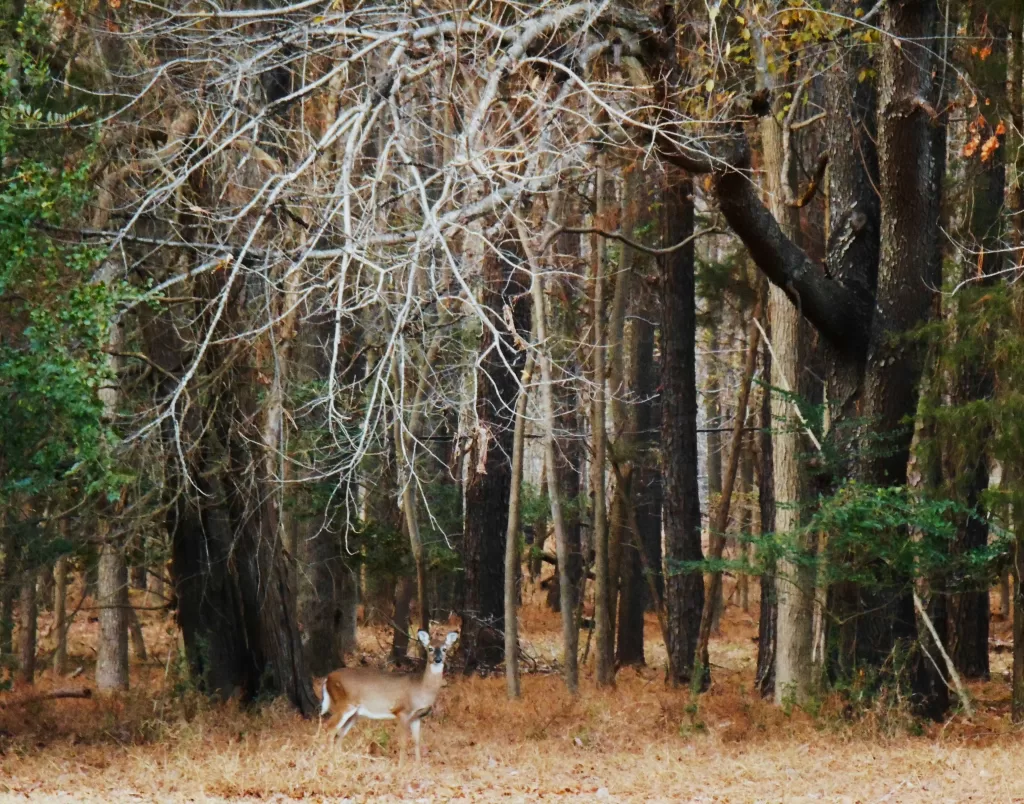
Deer live along the Colonial Parkway, near Jamestown. Deer were another important source of winter food for early colonists. Virginia deer season currently lasts from September through early January.
Animals slaughtered in December won’t need to be fed from precious stores of grain during winter, so meat is abundant for feasting. Fermentation of beer, ale, and cider is complete so strong drink is available. Yule logs are lit in the hearth and parties with dancing, games and song continue through the long nights. This was the original celebration at the solstice.
At the solstice, when the sun reversed direction, it became common for people to reverse their roles as well. The “Lord of Misrule,” from Rome’s Saturnalia celebration, survived in English custom and may have come with the early settlers to Jamestown. Dressed in colorful costumes with lace, ribbons, and bells, the “Lord of Misrule” and his merry company led the festivity and songs.

Evergreen mistletoe has a long history of use at Solstice celebrations, and is hung in ‘kissing balls’ today. Evergreen wreaths symbolize eternal life, and cones symbolize fertility and new life. Colonial Williamsburg Christmas Day 2016.
Christmas 1606 found the first Jamestown colonists still at sea on their small ships. They didn’t land at Jamestown Island until May 14 of 1607. Their first Christmas in Jamestown found them hungry and at odds with the local native tribes.
Captain John Smith, having been captured by the Powhatan, was carried to Chief Powhatan’s seat of government at Werowocomoco (current Gloucester County) where he was questioned by the chief about the colonists’ intent. The Jamestown colonists, one third of those who had arrived in May, huddled against the cold in their settlement over that first Christmas.

Mistletoe shines brightly on Winter Solstice December 21, 2016.
Little written record is left by diarists about those first Christmas celebrations in the Jamestown colony. We know that the colonists would have found an abundance of evergreen holly, pine, cedar, and mistletoe to cut for decorations if they wanted to brighten their living quarters. They had a minister, but no church building was put up until the following year, so their first Christmas service most likely was held under a temporary shelter or in a storehouse.
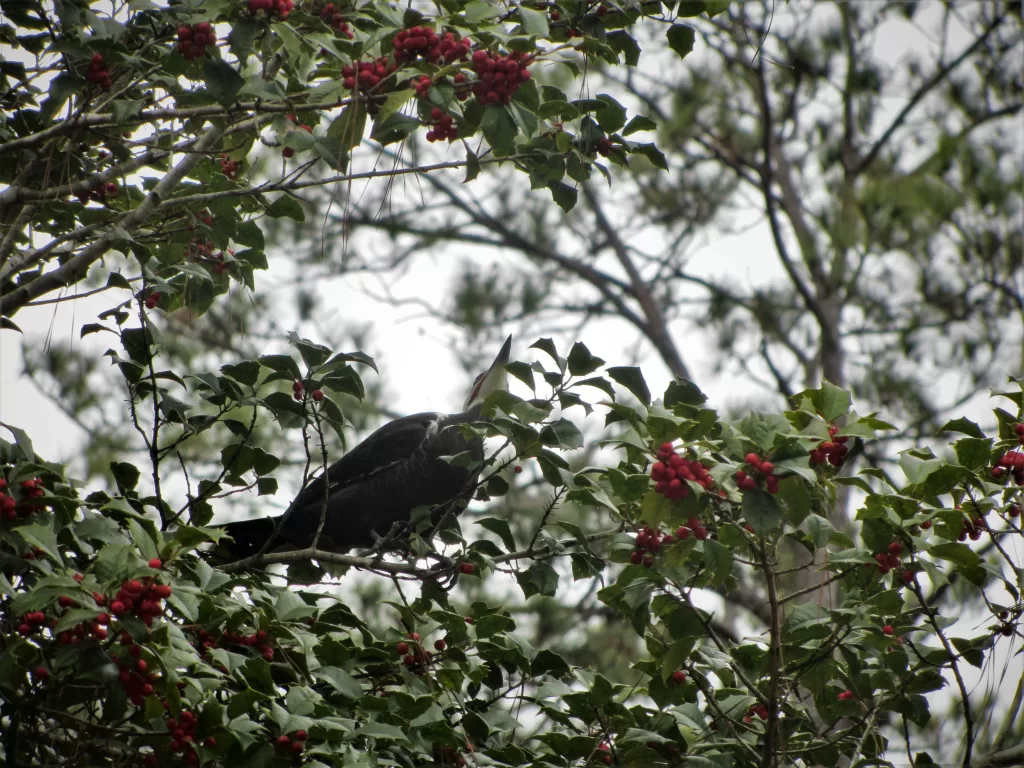
Native holly. Ilex opaca, December 2021
Christmas 1608 found Captain Smith and his men in Kecoughtan, modern Hampton, again on a mission to trade with the local natives for food. A fierce storm was blowing, and he stayed with the natives living there for about a week, during which they feasted on seafood and other native foods. Smith recorded in his diary, “There, the extreame wind, raine, frost, and snowe, caused us to keepe Christmas amongst the Salvages, where wee were never more merrie, nor fedde on more plentie of good oysters, fish, flesh, wild foule, and good bread, nor never had better fires in England then in the drie warme smokie houses of Kecoughtan.”
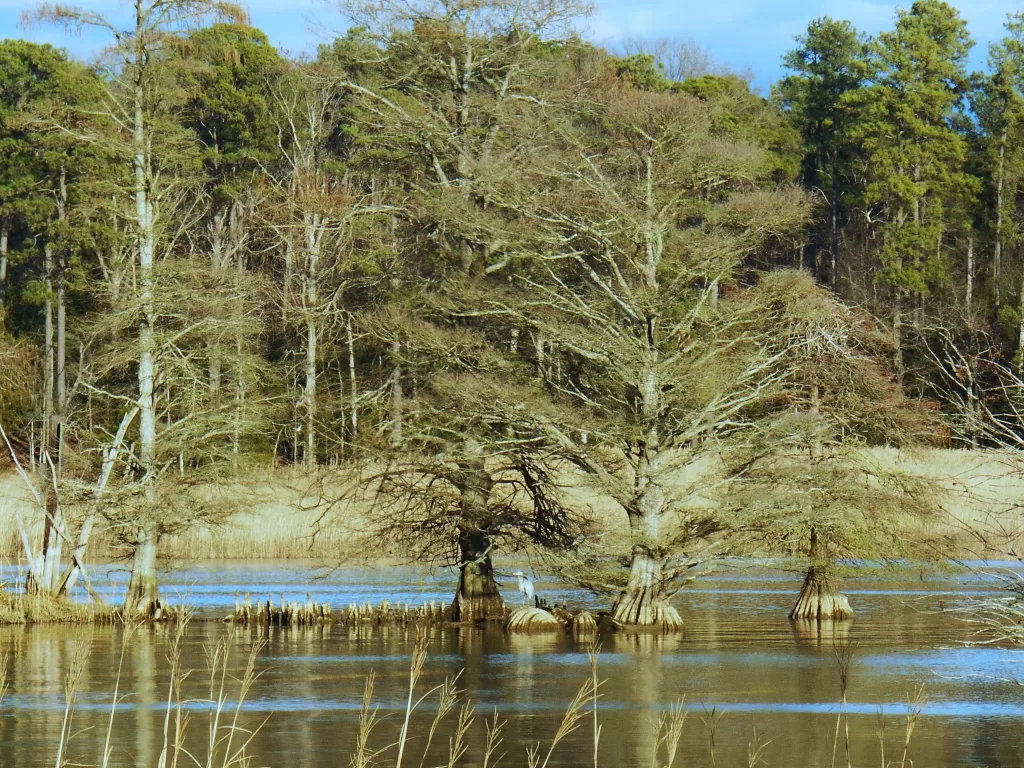
Powhatan Creek is one of the many waterways around Jamestown Island. Here, it empties into Sandy Bay beside the causeway linking the island to the mainland. It is a rich source of fish, shellfish, and birds. Cattails, and other edible marsh plants grow in abundance around the island. Bald Cypress trees, Taxodium distichum, stand bare in January 2017. Evergreen loblolly pines grow on the far shore of the creek.
The few records we have indicate that both winter and summer were hard on the early colonists, and that Christmas was remembered mainly with religious observances and carols. Surely a Yule log was lit for light and heat in the drafty shelters where the colonists lived together.
The colonists struggled during those early years. They were still searching for gold, and depended on trade with the local native American tribes for food. Captain Smith was able to facilitate trade, communicate with the native leaders, and also dispatch colonists to hunt and fish. Once he was injured in an accident in October of 1609 and returned to England for treatment, things went much worse for the colonists without his leadership.
We remember the winter of 1609-1610 as “the starving time” when all but 60 of the 500 colonists perished. They were prepared to abandon the colony and return to England when ships arrived in June bringing fresh supplies, a new governor, and a new group of colonists.

Native oakleaf Hydrangea turns scarlet in December. Winterberry holly, a native deciduous holly, is also used in holiday decorations. Evergreen ivy has been an important part of Solstice, and later Christmas celebrations since ancient times. Early colonists imported ivy to Virginia from Europe to use as ground cover. Colonial Williamsburg, December 2015.
Once the colony grew stronger and more secure, more English customs were reinstated. One of the much-loved customs from home, brought to Virginia, was ‘The Lord of Misrule’ who presided over the festivities. Dressed in a bright costume, he led the music making, games, feasting, drinking, dancing, and revelry on Christmas Day.
Colonists would have cut branches of American holly to decorate their homes at Christmas. It was much like the holly they were accustomed to having back home in England. They likely also used red cedar, pine, and mistletoe. Evergreen ivy was imported to Virginia early in the Colonial period to use as ground cover, and it was used as an evergreen in Christmas decorations. Magnolia leaves, popular in Christmas decorations today, didn’t grow as far north as Virginia in the early 17th Century.

Eastern red cedar grows on the bank of Sandy Bay near Jamestown Island. It provides food and cover for birds and attracts wildlife, is often cut as a Christmas tree, and is an excellent material for making Christmas wreathes and other decorations. 2014
Mistletoe has been used, along with other evergreens, to decorate for the winter solstice celebrations since ancient times. Its mythic associations with masculinity and fertility, and with marriage, have earned it a prominent place in “kissing ball” decorations, hung from doorways and chandeliers. Couples kiss under the mistletoe to seal engagements, cement friendships, make up after arguments, and often to begin new relationships.
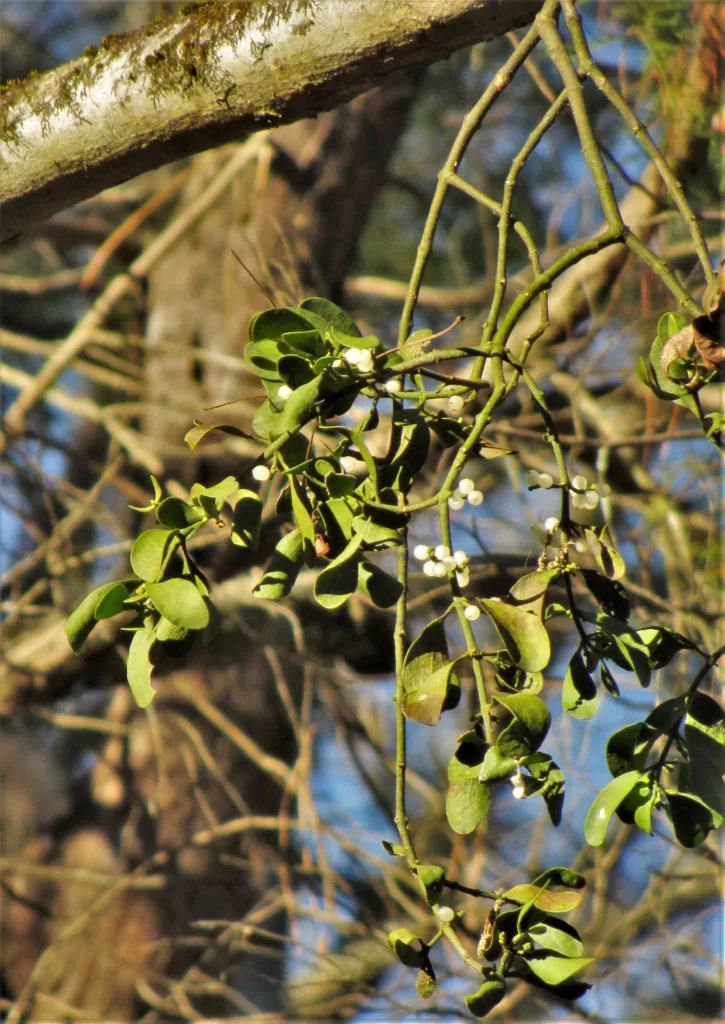
The white berries of mistletoe are often mixed with the red berries of holly in holiday decorations. Mistletoe berries are considered poisonous to humans when eaten, but are a very important food source for birds in winter. Mistletoe makes its own food through photosynthesis, but grows anchored into the bark of trees.
Back home in England, tensions over Christmas were already apparent. The Church of Scotland had banned Christmas in 1583. They recognized its strong roots in ancient ‘pagan’ cultures, and that most of its customs came from the Roman holiday called Saturnalia.
During the week long celebration of Saturnalia, beginning on December 17, masters and slaves changed places, with the masters serving their servants a feast. Every home was decorated with greens, herbs, fires, and candles. Normal rules and standards of behavior were generally relaxed during a week of parties, gaming, merry making, feasting, drinking and celebration. Government, schools, and many businesses shut down. Gifts were exchanged, music made, and bands of carolers even ran naked in the streets with their “Lord of Misrule.”
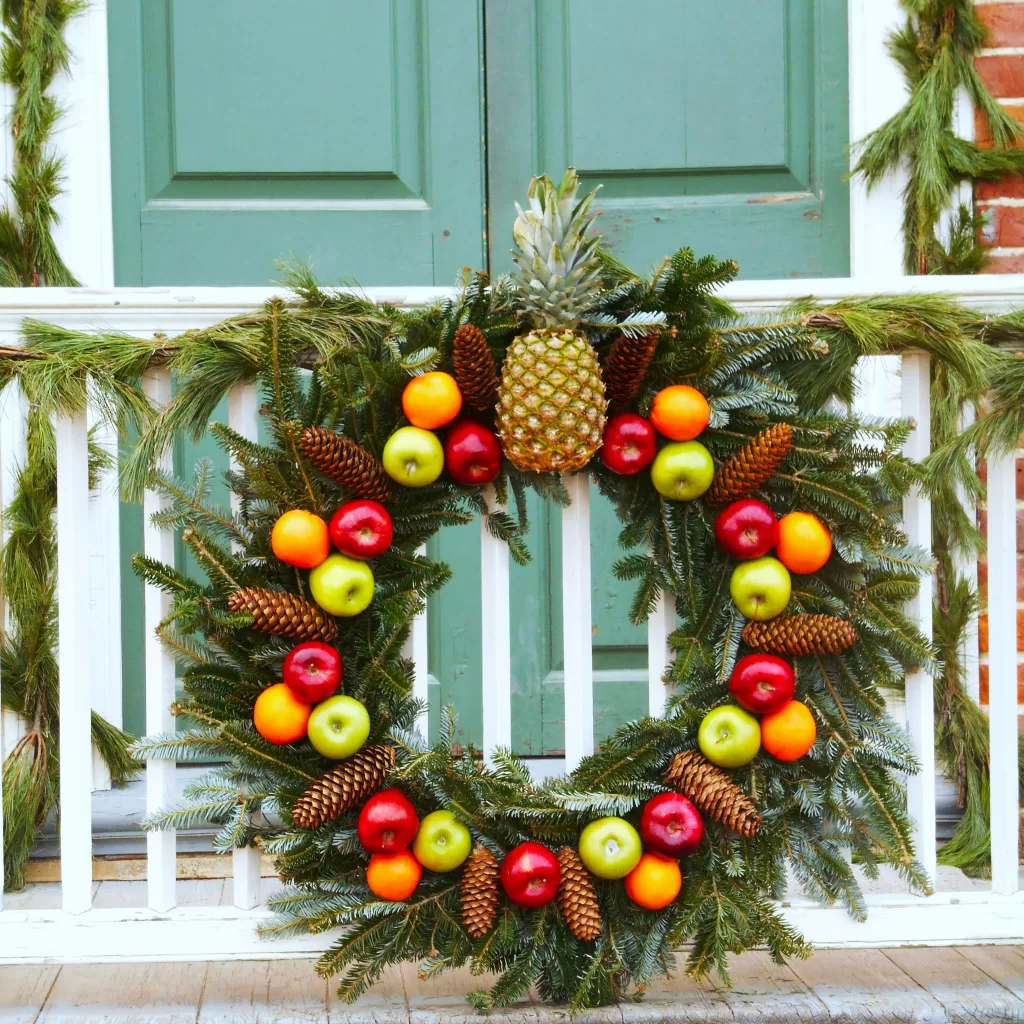
Pineapples became a symbol of hospitality and generosity in Colonial Virginia once it was established as an important node in the trade routes between England and the islands in the Caribbean. Citrus fruits, like oranges, also became available through the sea trade. Colonial Williamsburg December 2016.
Saturnalia celebrated the Roman god Saturn (Greek: Kronos or Cronus, ‘Father Time’) who ruled the astrological houses of Capricorn and Aquarius. Saturnalia began as the sun moved into the house of Capricorn in those days. Saturn’s brother, Janus, the ‘two faced god’ who looks both forwards and backwards, is also associated with Saturnalia and is often depicted at modern ‘New Year’ celebrations. Both Saturn and Janus ruled over Roman in ancient times. People decorated for Saturnalia with holly, considered sacred to Saturn, garlands of evergreens and red berries hung over doorways and windows, and alters to Saturn were decorated with candles and greenery. Light, illumination, was considered a ‘gift’ or ‘sacrifice’ to Saturn and so the public streets were illuminated, lighting the way for revelers.
Part of the Saturnalia celebrations included sharing food and drink, and giving small gifts to family, friends and associates. Gifts were exchanged on the last day of Saturnalia, December 23. Small, wax statues were popular gifts, and quite often those statues depicted Saturn, Janus, or other gods and goddesses who were a part of Roman civic life. Our tradition of giving gifts in late December can be traced back to this part of the Saturnalia celebrations. The later story of three kings of the East bringing gifts to the baby Jesus was used to continue the gift-giving tradition during the celebration of Christmas.

A boxwood, Buxus sempervirens, hedge encloses two sides of this formal parterre garden at Colonial Williamsburg. Evergreen boxwood was imported from Europe as the Virginia colony grew, and is frequently cut for use in Christmas decorations. It is prized for its fine, shiny green leaves.
In fact, when the Roman government decided to adopt Christianity in the mid-4th Century CE, they promised converts that they could keep their Saturnalia celebrations. The Gospels don’t record a year or date for the birth of Jesus. The detail about shepherds watching their flocks out in the fields indicates that he may have been born in the spring or summer, rather than in winter.
The new Roman Christian church adopted the date of December 25 for the birth of Jesus in 354 CE. This was the traditional date for the birthday of previous ‘sun gods,’ or ‘sons of God,’ including Horus, Osiris, Dionysus, Krishna, Cernunnos, and Mithra. (Rome had already been celebrating the birth of Mithra on December 25 for several centuries, when church leaders assigned that date to the birth of Jesus during the rein of Emperor Theodosius I.) These son gods were annually “reborn” on December 25, several days after winter solstice; when the days grew visibly longer once again and the sun itself was ‘reborn’ in the winter sky. Early church leaders, including St. Nicholas, believed they would gain more converts by keeping the festivals and celebrations that the people already enjoyed.

Southern Magnolia was unknown to early Virginia colonists because it grew further south along the East Coast in those times. Its large, glossy leaves are important in contemporary Christmas decorations. Here, it is used in a garland with red cedar, pine cones, pomegranates and an Osage orange at Colonial Williamsburg. December 2015
The gods and goddesses of ancient Egypt were also born of the sky goddess, Nut, during the final days of the year, which didn’t belong to any of the standard Egyptian months. When the sun god Ra, her grandfather, declared that Nut could not give birth on any day of the year; Thoth added five days to the old Egyptian calendar of 360 days so that Nut’s children (Isis, Osiris, Set and Nephthys, and Arueris) could be born.
Christ’s Mass, or Christmas, a fixture in the Roman Catholic Church, was not celebrated enthusiastically by the post-Reformation Protestant church leaders in Scotland and England. Christmas was banned in England by Oliver Cromwell’s government in 1652. The Puritan Massachusetts Bay colony banned the celebration of Christmas between 1659 and 1681. Celebrants could be arrested, fined, and punished for any observance of this “pagan” holiday.
Christmas was never outlawed in Virginia, and it was observed with feasting, music and revelry throughout the colony’s history. There were church services, and communities came together to mark the day. It was a far simpler affair than it is today, however, and barely rated a mention in most surviving diaries.
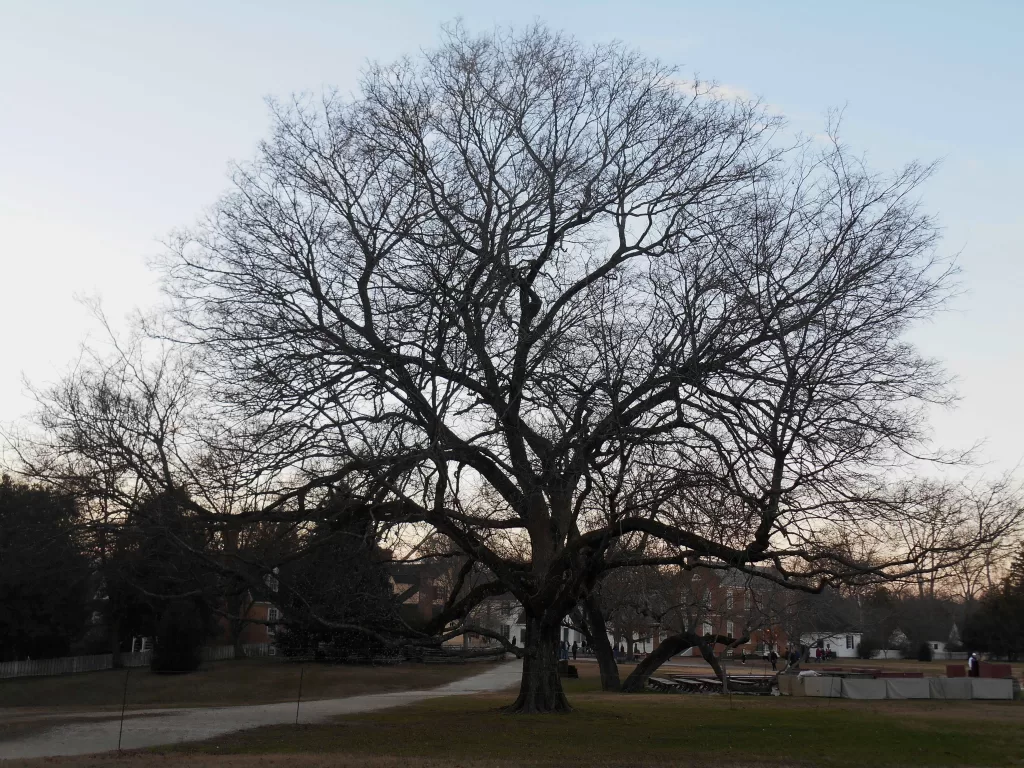
An American hackberry tree, Celtice occidentalis, stands bare on Christmas Day, 2016, near the Magazine at Colonial Williamsburg
All photos by E. L. McCoy
Many thanks to Master Gardener and Historic Site Supervisor of James Fort, Jay Templin, and to Rick Brown, Master Gardener Tree Steward and Colonial Williamsburg Volunteer for their assistance with this article.



